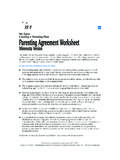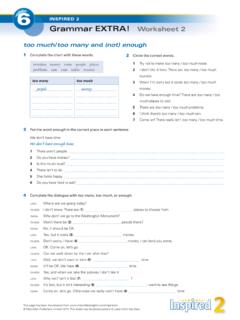Transcription of Chemistry 12 Worksheet 1-3 - Reaction Mechanisms
1 Print and send PDF files as Emails with any application, ad-sponsored and free of charge 12 unit 1 - Reaction Kinetics Worksheet 1-3 - Reaction Mechanisms Page 1 Chemistry 12 Worksheet 1-3 - Reaction Mechanisms 1. It is known that compounds called chlorof luorocarbons ( ) (eg. CFCl3) will break up in the presence of ultraviolet radiation, such as found in the upper atmosphere, forming single chlorine atoms: CFCl3 CFCl2 + Cl The Cl atoms then react with Ozone (O3) as outlined in the following mechanism. Step 1: Cl + O3 ClO + O2 Step 2: ClO + O Cl + O2 (si ngle "O" atoms occur naturally in the atmosphere.) a) Write the equation for the overall Reaction . (Using steps 1 and 2) _____ b) What is the catalyst in this Reaction ? _____ c) Identify an intermediate in this Reaction _____ d) Explain how a small amount of chlorofluorocarbons can destroy a large amount of ozone.
2 _____ _____ e) What breaks the bond in the CFCl3 and releases the free Cl atom? _____ 2. Given the following mechanism, answer the questions below: Step 1: O3 + NO NO2 + O2 (slow) Step 2: NO2 + O NO + O2 (fast) a) Give the equation for the overall Reaction . _____ b) What could the catalyst be in this mechanism? _____ c) What is an intermediate in this mechanism? _____ Print and send PDF files as Emails with any application, ad-sponsored and free of charge 12 unit 1 - Reaction Kinetics Worksheet 1-3 - Reaction Mechanisms Page 2 d) Given that the uncatalyzed overall Reaction is a slow exothermic Reaction , draw a potential energy graph which shows the possible shape of the curve for the uncatalyzed Reaction . On the same graph, show a possible curve for the catalyzed Reaction . Potential Energy Progress of Reaction 3.
3 Consider the following mechanism: Step 1: H2O2 + I- H2O + IO- (slow) Step 2: H2O2 + IO- H2O + O2 + I- (f ast) a) Give the equation for the overall Reaction . _____ b) What acts as a catalyst in this mechanism? _____ c) What acts as an intermediate in this mechanism? _____ 4. What is meant by the rate determining step in a Reaction mechanism? _____ _____ 5. What is meant by a Reaction mechanism? _____ _____ Print and send PDF files as Emails with any application, ad-sponsored and free of charge 12 unit 1 - Reaction Kinetics Worksheet 1-3 - Reaction Mechanisms Page 3 6. How are Reaction Mechanisms determined? _____ _____ 7. Given the following Potential Energy Diagram for a 3 step Reaction , answer the questions below it: a) Which arrow indicates the activation energy for the f irst step of the reverse Reaction ?
4 _____ b) Which arrow indicates the activation energy for the f irst step of the forward Reaction ? _____ c) Which arrow indicates the activation energy for the second step of the forward Reaction ? _____ d) Which arrow indicates the enthalpy change ( H) or "enthalpy change" for the overall forward Reaction ? _____ e) Which arrow indicates the enthalpy change ( H) or "enthalpy change" for the overall reverse Reaction ? _____ 12345 POTENTIAL ENERGYPROGRESS OF Print and send PDF files as Emails with any application, ad-sponsored and free of charge 12 unit 1 - Reaction Kinetics Worksheet 1-3 - Reaction Mechanisms Page 4 f) Which arrow indicates the activation energy for the overall forward Reaction ? _____ g) Which step would be the rate determining step in the f orward Reaction ? _____ h) In a dashed line or another colour sketch a possible curve that would represent the route for the uncatalyzed overall Reaction .
5 Label this on the graph. 8. Given the Reaction : 4 HBr + O2 2H2O + 2Br2 a) Would you expect this Reaction to take place in a single step? _____ Why or why not? _____ b) This Reaction is thought to take place by means of the following mechanism: Step 1: HBr + O2 HOOBr (slow) Step 2: HBr + HOOBr 2 HOBr (fast) Step 3: 2 HBr + 2 HOBr 2H2O + 2Br2 (fast) c) Identify the two intermediates _____ d) A catalyst is discovered which increases the rate of Step 3. How will this affect the rate of the overall Reaction ? _____ Explain your answer. _____ _____ e) A catalyst is discovered which increases the rate of Step 1. How will this affect the rate of the overall Reaction ? _____ Explain your answer.
6 _____ _____ f) Which step has the greatest activation energy? _____ Print and send PDF files as Emails with any application, ad-sponsored and free of charge 12 unit 1 - Reaction Kinetics Worksheet 1-3 - Reaction Mechanisms Page 5 g) How many "bumps" will the potential energy diagram for the Reaction mechanism have? _____ h) Which step is called the rate determining step in this mechanism? _____ i) In order to have successful collisions, the colliding particles must have both the proper amount of energy and the proper _____ j) On the set of axes below, draw the shape of the curve you might expect for the Reaction in this question. The overall Reaction is exothermic! Make sure you get the "bumps" the correct relative sizes. Potential Energy Progress of Reaction 9. The equation for an overall Reaction is: I- + OCl- IO- + Cl- a) The following is a proposed mechanism for this Reaction .
7 One of the species has been left out. Determine what that species is and write it in the box. Make sure the charge is correct if it has one! Step 1: OCl- + H2O HOCl + OH- ( fast ) Step 2: I- + HOCl IOH + Cl- ( slow ) Step 3: IOH + OH- + H2O ( fast ) b) Which species in the mechanism above acts as a catalyst? _____ c) Which three species in the mechanism above are intermediates? _____ d) Step _____ is the rate determining step. Print and send PDF files as Emails with any application, ad-sponsored and free of charge 12 unit 1 - Reaction Kinetics Worksheet 1-3 - Reaction Mechanisms Page 6 e) On the set of axes below, draw the shape of the curve you might expect for the Reaction in this question. The overall Reaction is endothermic! Make sure you get the "bumps" the correct relative sizes.
8 Potential Energy Progress of Reaction 10. Given the following steps for a mechanism: Step 1: Br2 2Br (f ast) Step 2: Br + OCl2 BrOCl + Cl (slow) Step 3: Br + Cl BrCl (f ast) a) Write the equation for the overall Reaction . _____ b) A substance is added that decreases the activation energy for step 1. Will this speed up, slow down, or have no effect on the rate of the overall Reaction ?_____ Give a reason for your answer. _____ c) Is there a catalyst in this mechanism? _____. If so, what is it? _____ d) Is there an intermediate in this mechanism?_____. If so, what is it? _____ e) Which step is the rate determining step? _____ Print and send PDF files as Emails with any application, ad-sponsored and free of charge 12 unit 1 - Reaction Kinetics Worksheet 1-3 - Reaction Mechanisms Page 7 11.
9 The following potential energy diagram refers to a very slow one-step Reaction of ozone (O3) and oxygen atoms in the upper atmosphere. On the axis below, draw a potential energy diagram which could represent the catalyzed mechanism for the Reaction : Step 1: O3 + NO NO2 + O2 (slow) Step 2: NO2 + O NO + O2 (fast) 050100150200250 Progress of ReactionPE (kJ)0 050100150200250 Progress of ReactionPE (kJ)0O + Print and send PDF files as Emails with any application, ad-sponsored and free of charge 12 unit 1 - Reaction Kinetics Worksheet 1-3 - Reaction Mechanisms Page 8 12. A certain chemical can provide a Reaction with an alternate mechanism having a greater activation energy. What will happen to the rate of the Reaction when this chemical is added? _____ Explain your answer. _____ _____ 13.
10 The following overall Reaction is f ast at room temperature: H+ + I- + H2O2 H2O + HOI A student proposes the following two-step mechanism for the above Reaction : Step 1 : H+ + H+ + H2O2 H4O22+ Step 2 : H4O22+ + I - H2O + HOI + H+ Would you agree or disagree with this proposed mechanism? _____ Explain your answer _____ _____ 14. Consider the following Reaction : CO + NO2 CO2 + NO a) The f irst step in each of two proposed Reaction Mechanisms for the above Reaction is listed below. If each proposed Reaction mechanism consists of only two steps, determine the second step f or each mechanism. Proposed Mechanism One: Step 1: 2NO2 NO3 + NO (slow) Step 2: _____ (fast) Proposed Mechanism Two: Step 1: 2NO2 N2O4 (fast) Step 2: _____ (slow) b) Experimental data show that the rate of the Reaction is not affected by a change in the [CO].










